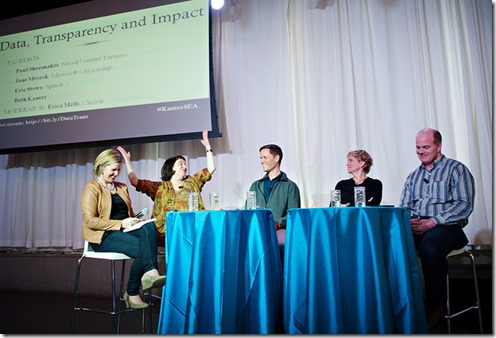Highlight Reel from ‘Data, Transparency, and Impact’ Panel
Guest post by Erica Mills
It could’ve been the beginning of a really bad joke: “Two funders, a nonprofit executive, and a blogger walked into this bar…” Instead, it was a curated conversation --with Jane Meseck (Microsoft Citizenship), Paul Shoemaker (Social Venture Partners), Eric Stowe (Splash), and Beth Kanter-- about data, transparency and impact, that took place on February 11.
My job was to keep the conversation—which could’ve stretched across days and weeks and years (and has, in many ways)—on track. What was the conversation, you ask?
For those who like crib notes, Beth did a fantastic storify summary.
For those who like the full meal deal, the video is available on-line.
For those who like a highlight reel with color commentary, read on.
Highlight #1: “Is measuring data about proving it or improving it?” @Kanter
Splash has a platform called Proving It. On the platform, they show the status of all the water systems they’ve installed. If one of their water systems isn’t working, everyone finds out at the same time. There’s no lag between when Eric finds out and donors do. This level of transparency is practically unheard of, not just among nonprofits, but across all sectors. It’s downright impressive. So, when Beth said, “Is it about proving it or improving it?” there was a collective, “Oooooh, good point.” The loudest ‘oooooh’ came from Eric himself who is not interested in doing it right, so much as doing it as well as they possible can in order to get more kids more clean water. Proving it is one thing. Thus his zeal for data. Using that proof to increase impact is quite another. Beth’s question snapped the prove/improve frame into sharp focus for everyone.
Highlight #2: “If an organization can’t prove impact, don’t fund them.” @EricStowe
Pretty sure there are people out there still suspended in a state of disbelief and awe that Eric said this, like, out loud. Sure, we may have thought it and we may, as individual donors, have decided not to fund an organization because they couldn’t demonstrate impact, but few people who work in the let’s-make-the-world-a-better-place space would admit it publicly! Isn’t it good enough that people are doing good in the world?! Nope. Turns out people were just waiting for someone else to go first, to admit that we now live in an era when good intentions aren’t good enough, when data showing that those good intentions are making a “ding in the universe”, as Steve Jobs used to say, is what’s needed and expected if you’re going to get funded. And, per the audience Q & A, if it’s in story form, all the better!
There’s an outstanding question on this: how high are we setting the bar for showing impact? Most organizations gather data on outputs, but as you move out the logic model to outcomes and then, eventually, larger-scale impact, it gets harder—and more expensive—to gather and analyze the data. Although we kicked off the panel by defining impact, the question of standards is still dangling out there, unresolved.
Highlight #3: “Reporting requirements should be commensurate with the size of a grant.” @JaneMeseck
As with so many things in life, this question of how much impact an organization can show comes down, to a certain extent, to money. Jane made it clear that funders need to better align their expectations—if you expect organizations to measure impact, fund it. It costs money to gather the data. It also costs money to interpret the data. This interpretation and application part is critical and yet few organizations have the expertise to do it well. So, it’s not just a matter of funding data collection, but also funding the translation of the data into something actionable, so it can increase impact.
The acquisition of actionable information that leads to impact should be a standard part of every grant.
Highlight #4: “Should we do the failure bow?” @Kanter
Heck yeah, we should do a failure bow! We should do them all the time. The failure bow comes from improv. It’s an artful way of saying, “I messed up and it’s okay!” If we never fail, we’re not trying hard enough or dreaming big enough. If we never fail, we’re playing it way too safe. And yet, failing is looked down upon. Which, unfortunately, is counter-intuitive—you can’t succeed without failing along the way. I tell ya, everyone there did the failure bow and it really does feel awesome. (Go ahead, try it. Stand up, hands in the air, yell “I failed!” in a jubilant tone, and then take a great, big bow. Seriously awesome. Whew.) When in doubt, always do a failure bow.
Highlight #5: “Funders have to lead when it comes to transparency, own up to failures and create air cover for NGOs showing failure.” @paulshoeSVP
Pursuant to #4 above…changing the world is a team sport. We’ve all got to try and therefore, we’re all, on occasion, going to fail. Now that we have the failure bow down, this might come more easily. But it’s going to take time before failing is fashionable. Paul made the case for funders leading the charge on this. This would be a paradigm shift, one that might—just might—be what we need to kick up our collective impact a whole bunch of notches.
This is just the tip of the impact iceberg when it comes to insights this panel offered. If you’re interested in how embracing data and transparency can lead to increased impact, I encourage you to watch the entire discussion. Plus, as an added bonus, you’ll learn how Beth got her start as a trainer at the tender age of 5 (and got local parents in a tizzy), what Eric did between high school and college, what Paul does in his spare time (it involves a whistle), and how Jane got her butt kicked last summer by her philanthropically-minded son.
 |
About Erica Mills, founder & CEO of Claxon
Erica is an internationally recognized expert on mission-driven messaging and marketing strategy. She is invited regularly to speak on marketing and communications strategy, and using words to change the world. Erica is the author of Pitchfalls: why bad pitches happen to good people . She is also the creator of the 1, 2, 3 Marketing Tree, a tool that makes mission-driven marketing simple and effective. Erica teaches for the University of Washington’s Certificate of Nonprofit Management, the Evans School of Public Affairs, and guest lectures at the University of Chicago. |

